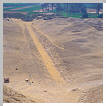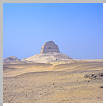Of all the pyramids in Egypt, this is certainly
the strangest looking. Believed to be a work of Sneferu and possibly started
by his father Huni, the last king of the 3rd dynasty. The Pyramid at Meidum
certainly represents a transition in architecture, built of large limestone
blocks. It also represents the transition from the Third to the Fourth dynasties.
The site was visited in 1799 by Napoleon, but the famous draftsman Denon
was able to make only a few sketches and prepare a short description of
the pyramid. It was investigated and measured much more carefully by Perring
in 1837 and especially by the Lepsius expedition in 1843. However the inside
of the structure remained inaccessible. Maspero was the first to open the
pyramid and some of the mastabas in the area, in the framework of a wide-ranging
archeological project whose goal was to discover and document the pyramids
texts.
Archeological investigations of the Meidum Pyramid began precisely ten years
later (1853). These were led by no less a figure than Petrie, the founder
of modern Egyptian archeology, in collaboration with his compatriots, the
Architect George Fraser and the Egyptologist Percy Newberry. They investigated
the inside of the pyramid and discovered the pyramid temple, an approach
causeway, and a series of private tombs in the area around the pyramid.
After a long interruption Petrie again returned to Meidum with Egyptologists,
Ernest Mackay and Gerald Wainright. They tunneled into the pyramid and discovered
that the core is composed of five accretion layers, inclined at an angle
of seventy-five degrees and standing on a square base about thirty-eight
meters on a side, whose outer surfaces were built of carefully dressed limestone
blocks. In the mid-1920's Borchardt arrived at Meidum and within a few days
accumulated so much knowledge that it filled a whole book, still highly
regarded today: Die Entstehung der Pyramide an der Baugeschichte der Pyramids
bei Meidum nachgewiesen. He even reconstructed, on the basis of the ruins,
a corridor leading toward the pyramid from the southeast, which Petrie discovered
in 1910, and which in his opinion was used to transport construction materials.
The ramp had a gradient of ten degrees and made it possible to construct
the lower half of the pyramid, which composes 88.5 percent the total volume
of the pyramid.. The builders increased the increased the gradient on the
upper half of the ramp. In the late 1920's Kurt Medelssohn was visiting
the Pyramid has a tourist and was intrigued by the mound of debris surrounding
the pyramid. He published a book The Riddle of the Pyramid, which
became in instant best seller. Medelssohn theories based on physics, however
has not convinced Egyptologist. The bizarre, truncated pyramid is today
about sixty-five meters high. Borchardt believes that the structure was
built in three stages E1, E2 and E3. The entry to the pyramid is on the
north-south axis, in the north wall , about fifteen meters above ground
level.




























